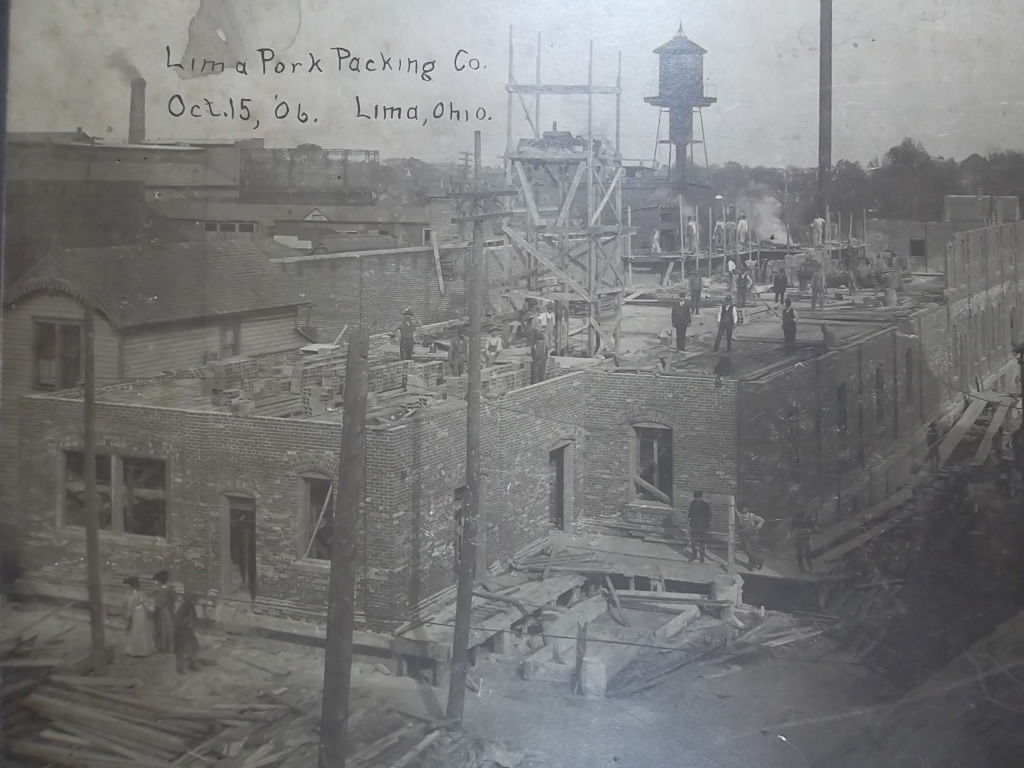LIMA PORK PACKING COMPANY / The Lima Packing Company:
- This company was incorporated on October 1, 1901, with a capital stock of $60,000 [$1.5 million, today].
- The first year the firm was located in a small building, which stood where the electric light plant now stands. There the firm occupied but one room and employed only eight men.
- At present [1906] it is located on South Central avenue just south of the Model Mills. In contrast with the one room, it has now two buildings, each two 'stories high.
- The pay-roll now shows 35 men employed, including three traveling salesmen.
- The annual volume of business aggregates $300,000 [almost $8 million today].
- The company buys and slaughters all of its own live stock, practically all of which comes from the surrounding country, and manufactures all kinds of packing house products.
- Its equipment includes unsurpassed cold storage facilities.
- The officers are : B. F. Thomas, president ; Ira P. Carnes, vice-president; W. C. Bradley, treasurer; O. W. Leichty, secretary.
They did not keep the word PORK.
- Walter C. Bradley, born in 1866, passed in 1958.
- In about 1895 he went to Chicago with Swift & Co. meat packers and subsequently became branch manager in Toledo, Erie, Pa. and Lima.
- In 1898 he associated himself with the late Benjamin F. Thomas in forming the Lima Packing Company.
- He spent his entire business life in Lima with the packing company, of which he was president for many years.
- [from his obituary]
[source]
ca. 1854, [daguerreotype portrait of a butcher with his tools, hand-tinted blood detail on knife], Edward M. Tyler
Meat packing plant, circa 1873.
The Meat Packing Industry
In 1747, an ordinance in the United States “forbade people from slaughtering cattle at their home." An additional motivation for eliminating private slaughter was to allow for the careful regulation of the “morally dangerous” task of putting animals to death.
This new demand for concealment and regulation, combined with a continued demand for meat led to the primacy of the “slaughterhouse” as a unique site for the killing of animals for meat.
Technical innovations catapulted the growth of the meat industry. The invention of the refrigerator car as well as expansion of the railroad allowed for feasible, safe transportation of meat (and later enabling the isolation of slaughterhouses outside of population centers).
Additionally, Meat-packing millionaire [Philip Armour]’s invention of the “disassembly line” greatly increased the productivity and profit margin of industrial meatpacking businesses: “according to some, animal slaughtering became the first mass-production industry in the United States, from which Henry Ford partially adapted his conception of assembly-line production. The industry continued to expand during this period as a result of increasing demand and increased distribution possibilities.”
More: Read about the Meatpacking Industry in Chicago - link - From the Civil War until the 1920s Chicago was the country's largest meatpacking center and the acknowledged headquarters of the industry.
A meat packing plant in the 1910s.
Reform in the Food Industry
Upton Sinclair published The Jungle in 1905 to expose labor abuses in the meat packing industry. But it was food, not labor, that most concerned the public. Sinclair's horrific descriptions of the industry led to the passage of the Pure Food and Drug Act and the Meat Inspection Act, not to labor legislation. [Source]
Soldiers in Aprons: The Housewives Who Changed America
“Housewives League” chapters began springing up in just about every corner of the country with local groups of women and wives ready to do battle in the marketplace to force the stores and food producers to clean up their act. [Source]
The Detroit Housewives’ League took on the meat packing industry itself. In 1935, they burned a huge packinghouse in protest of high prices, and they joined thousands of Chicago housewives in a march that shut down that city’s entire meat industry. [Source]
_____________________
Note: These items are part of my ''Collecting Lima Virtual Museum''. They are not for sale.
If/when I find more information on these items, I will add it to the post.
Read the Introduction to Collecting Lima Virtual Museum Project ~ My Lima Ohio Bottles, Advertising, Antiques
Note: These items are part of my ''Collecting Lima Virtual Museum''. They are not for sale.
If/when I find more information on these items, I will add it to the post.
Read the Introduction to Collecting Lima Virtual Museum Project ~ My Lima Ohio Bottles, Advertising, Antiques
________________________
Sign up for my free newsletter!

























